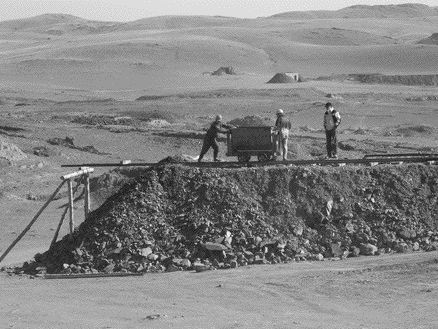Vancouver — With three shiny gold bars in hand, joint-venture partners
Well positioned in the central Tian Shan gold belt, the CSH 217 gold project is a large-tonnage, low-grade deposit that has undergone extensive small-scale, artisanal mining for centuries.
In April 2002, Jinshan, which translates to “Gold Mountain” in Chinese, acquired an option on the project to earn a 96.5% interest for payments of US$750,000 over three years, plus another $2 million in two payments, one when project construction started and another once the operation began commercial production. The company has since fully earned its interest.
Jinshan’s major shareholder, Ivanhoe, later elected to participate in the project on a 50-50 joint-venture basis.
In 2004, Jinshan launched an aggressive exploration program aimed at delivering a revised resource estimate for the gold deposit. The new resource figure, released in early-2005, more than doubled previous estimates. The resource now stands at 83 million tonnes grading 0.8 gram gold per tonne for 2.2 million contained ounces.
Additionally, inferred resources were boosted to 37 million tonnes averaging 0.9 gram gold or 1 million contained ounces. The National Instrument 43-101-compliant estimate was conducted by engineering firm GeoSystems International and was based on 2004 drilling, using a 0.5-gram gold cutoff and a gold price of US$400 per oz.
That same year, Jinshan started open-pit pilot-mining, extracting about 100,000 tonnes of oxidized gold mineralization for heap-leaching and bulk-tonnage testing. The pilot plant consists of a 1,000 tonne-per-day crusher and conveyor system supplying ore to two 50,000-tonne leach pads. Test leaching was designed to assess both run-of-mine and single-stage crushed ore. Furthermore, a 300-metre decline was built to access deeper, sulphide mineralization for testing.
Pilot testing began in May, and by August had produced 580 oz. gold. Leaching will continue until October, thereby providing further metallurgical and recovery data.
Jinshan president Jay Chmelauskas described the results of the leach-pad testing as “better than expected,” adding that the material had proven to be quite permeable.
The deposit is hosted within a package of sheared Proterozoic-to-Mesozoic sediments that have undergone extensive structural fracturing, faulting and folding. Two Paleozoic granitic intrusives, to the north and south, are believed to be associated with mineralization. Gold is generally fine-grained, occurring within thin quartz-sulphide seams and stringers along bedding plane shears.
Three principal mineralized zones have been identified at CSH 217: the Northeast, Southwest and Central. Over 20,000 metres of drilling have been conducted, primarily on the Northeast and Southwest zones.
Permitting and pit-engineering studies are now under way at CSH 217. The deposit is close to infrastructure, with the industrial city of Baotou, situated 200 km south along a paved highway. To the north, across the Mongolian border, sits Ivanhoe’s Oyu Tolgoi large-tonnage copper-gold project.
One wrinkle of note is that investment fund managers often prefer that projects have only one owner, this has Jinshan looking at ways to consolidate ownership in the CSH 217 mine. In one likely scenario, Jinshan would issue equity to Ivanhoe in exchange for its 50% interest, which would give the senior company a controlling position in Jinshan. Ivanhoe already holds 18.7 million shares, or 38.6% of the company.
With a production goal of 100,000 oz. gold per year, Jinshan views the planned 10,000- to 15,000-tonne-per-day CSH 217 mine as a beachhead in its corporate strategy.
With its working capital generated from the CSH 217 operation Jinshan will seek other gold projects throughout China.
The company recently traded at 55 per share, giving it a market capitalization of $27 million based on 48.5 million shares outstanding.


Be the first to comment on "Jinshan Gold pours first bullion bars"